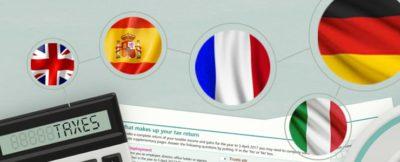Federal and international regulatory developments give new relevance to Swiss procedures for spontaneous regularisation in terms of income and wealth tax, which came into force on 1 January 2010. We offer a brief summary of these mechanisms, which must now be placed into perspective with the new rules for the automatic exchange of information due to enter into force by 2018. It should be noted right away that two so-called “non-punishable voluntary disclosure” procedures currently exist, one reserved for taxpayers who have not previously declared certain elements of their income or assets, and the other for beneficiaries of an estate, which concerns taxes not paid by the deceased relative in question.
CONTENTS
Voluntary disclosure of tax evasion, ARTICLE 175 of the LIFD (Loi fédérale sur l’impôt fédéral direct. – Swiss federal law on direct taxation) and 69 AL.3 of the LPF (Loi de procédure fiscale – Tax procedure law)
This mechanism is much less financially appealing than that reserved for beneficiaries of an estate (see Table I below), which may explain the fact that until recently, taxpayers who have not been entirely honest with the tax authorities have steered clear of this procedure, preferring to take a gamble and live by the famous French maxim “pas-vu-pas pris” (literally, “not seen, not caught”). However, today, this approach should be strongly discouraged – the Automatic Exchange of Information (EAR) revolution is well underway, and it appears that nothing can stop it. These new EAR regulations (which will mainly concern EU and OECD countries) are complex and costly to implement for banks, but it is understood that the collection of information will begin in 2017 and that the exchange process will be effective in Switzerland as of 1 January 2018.
We can therefore be sure that very few undeclared assets will escape the knowledge of the federal tax authorities. The tax authorities will have access to a very significant amount of information concerning undeclared assets abroad, and will have the power to fine or even bring criminal charges against the last die-hard secretive individuals who have not made the necessary provisions ahead of this deadline.
Where the tax authorities discover elements of income and assets that have not been declared by the taxpayer, they will impose a tax surcharge for the previous 10 years, plus default interest, as well as a fine on the taxpayer of up to 3 times the value of the unpaid taxes. The latter may also face the possibility of prosecution. The voluntary disclosure procedure enables taxpayers to avoid fines and criminal proceedings, but the tax surcharge for the previous 10 years, plus interest, will still be due.
Naturally, each taxpayer can only make a voluntary disclosure once. In addition, this disclosure will be entered into a federal register, in order to check that this is indeed the first disclosure made by the individual in question. The voluntary disclosure is also subject to three conditions:
- 1) That no tax authority is aware of the tax evasion to which the disclosure refers,
- 2) That the taxpayer cooperates fully with the authorities in order to determine the amount of tax that remains unpaid
- 3) That he or she endeavours to pay the sums that are due.
| Income and assets not declared by the taxpayer | |
| The tax authority discovers assets not declared | The taxpayer voluntarily discloses for the first time assets not declared |
|
|
VOLUNTARY DISCLOSURE BY THE BENEFICIARIES OF AN ESTATE, ARTICLE 153A of the LIFD AND 72 AL.4 of the LPF
The tax authority may notify beneficiaries of additional tax liabilities with default interest regarding tax evasion disclosures made by the deceased. Even if the beneficiary can no longer be fined (pursuant to the decision of the European Court of Human Rights in 2004), the amount inherited from the estate can disappear in a flash, due to the fact that the tax authorities can go back for a period of 10 years prior to death.
The procedure for voluntary disclosure by the beneficiaries of an estate makes it possible to limit the period to which additional tax can be applied to the 3 years before death – an extremely favourable system which is particularly appropriate in situations in which beneficiaries wish to benefit from the assets left to them by their deceased relative.
It should be noted that the text provides for the possibility that each beneficiary may use the voluntary disclosure procedure independently of the other beneficiaries of the estate in question. However, we encourage beneficiaries not to avoid collective consultation on the strategy to pursue with regard to voluntary disclosure, as the initiatives precipitated by one or more beneficiaries could obviously deprive the others of the possibility of benefiting from this procedure. Indeed, the first of the conditions that must be met in order to benefit from the simplified 3-year additional tax liability is to ensure that no tax authority is already aware of the tax evasion that has taken place. Clearly, then, beneficiaries must consult with one another, and come to an agreement among themselves before filing the inheritance declaration.
Traditionally, the other conditions include the stipulation that taxpayers cooperate fully with the authorities in order to determine the amount of tax that remains unpaid, and that they endeavour to pay the sums that are due. For the sake of completeness, it should also be noted that the simplified 3-year additional tax liability is not applicable in the event of the official liquidation of the estate or the liquidation of the estate in accordance with bankruptcy proceedings, and that nothing in the text seems to suggest that the same beneficiary cannot benefit from the voluntary disclosure procedure for several distinct estates. Table II (below) provides a quick overview of the choices available to beneficiaries of an estate.
| Income and assets not declared by the taxpayer | |
| The tax authority discovers assets not declared by the deceased | The beneficiary voluntarily discloses assets not declared by the deceased |
|
|
WHAT STRATEGY SHOULD BE ADOPTED?
When dealing with inheritance, the simplified additional tax liability system is in most cases both highly appropriate and extremely favourable for an inheritor who wishes to ensure that the estate of which he or she is a beneficiary complies with the regulations in force, with regard to the tax evasion committed by the deceased. Where necessary, he or she must simply confer with the other beneficiaries, and above all, must not delay in making a decision – once the tax authorities become aware of the undeclared assets belonging to the deceased, it will be too late!
As far as taxpayers are concerned, the number one key to a good strategy, in our view, is anticipation. The collection of information under the new EAR regulations, which will begin in 2017, means that there is very little time left for taxpayers who have evaded tax on personal income or wealth to seek advice, working closely with the bank concerned where monetary assets are concerned. In order to estimate the additional tax due, and to discover the fate that awaits the taxpayer, we recommend getting in touch with a qualified professional (a Swiss fiduciary or lawyer), in order to assess the situation and estimate the past and future costs stemming from a voluntary disclosure. In reality, additional tax liabilities can have collateral effects on the past (demands for reimbursement of social benefits that, in retrospect, were not due, for VAT payments avoided, for social welfare payments not made, etc.). Furthermore, the tax burden on the taxpayer, notably with regard to wealth, will be increased in the future, as a result of the addition of all of the elements that were previously not declared.
Accordingly, Swiss tax regularisation requires a thorough analysis of the situation by a qualified professional, who will know which other experts to consult (bankers, solicitors, etc.), providing the taxpayer with all the information he or she requires to make a fully informed decision.
Get a free assesment
Our team of best tax and legal experts, lawyers, accountants and financial advisors answer your question and assist you in achieving your goals




